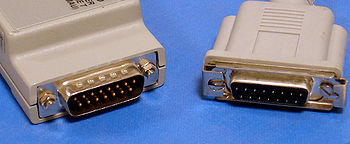
Attachment Unit Interface
Encyclopedia

Ethernet
Ethernet is a family of computer networking technologies for local area networks commercially introduced in 1980. Standardized in IEEE 802.3, Ethernet has largely replaced competing wired LAN technologies....
interface and the Medium Attachment Unit
Medium Attachment Unit
A Medium Attachment Unit is a transceiver which converts signals on an Ethernet cable to and from Attachment Unit Interface signals.On original 10BASE5 Ethernet, the MAU was typically clamped to the Ethernet cable...
(MAU), sometimes known as a transceiver
Transceiver
A transceiver is a device comprising both a transmitter and a receiver which are combined and share common circuitry or a single housing. When no circuitry is common between transmit and receive functions, the device is a transmitter-receiver. The term originated in the early 1920s...
. It is the part of the IEEE
Institute of Electrical and Electronics Engineers
The Institute of Electrical and Electronics Engineers is a non-profit professional association headquartered in New York City that is dedicated to advancing technological innovation and excellence...
Ethernet standard located between the Media Access Control
Media Access Control
The media access control data communication protocol sub-layer, also known as the medium access control, is a sublayer of the data link layer specified in the seven-layer OSI model , and in the four-layer TCP/IP model...
(MAC), and the MAU. An AUI cable may be up to 50 meters long, although frequently the cable is omitted altogether and the MAU and MAC are directly attached to one another.
AUI connectors became rare beginning in the early 1990s when computers and hubs began to incorporate the MAU, particularly as the 10BASE-T
10BASE-T
Ethernet over twisted pair technologies use twisted-pair cables for the physical layer of an Ethernet computer network. Other Ethernet cable standards employ coaxial cable or optical fiber. Early versions developed in the 1980s included StarLAN followed by 10BASE-T. By the 1990s, fast, inexpensive...
standard became more common and use of 10BASE-5 (thicknet) and 10BASE-2 (thinnet) declined. The electrical AUI connection was still present inside the equipment. By the mid-1990s AUI had all but disappeared as fast Ethernet
Fast Ethernet
In computer networking, Fast Ethernet is a collective term for a number of Ethernet standards that carry traffic at the nominal rate of 100 Mbit/s, against the original Ethernet speed of 10 Mbit/s. Of the fast Ethernet standards 100BASE-TX is by far the most common and is supported by the...
became more common (fast Ethernet has an equivalent known as Media Independent Interface
Media Independent Interface
The Media Independent Interface was originally defined as a standard interface used to connect a Fast Ethernet MAC-block to a PHY chip.The MII design has been extended to support reduced signals and increases speeds...
, MII). Gigabit Ethernet
Gigabit Ethernet
Gigabit Ethernet is a term describing various technologies for transmitting Ethernet frames at a rate of a gigabit per second , as defined by the IEEE 802.3-2008 standard. It came into use beginning in 1999, gradually supplanting Fast Ethernet in wired local networks where it performed...
and 10 gigabit Ethernet
10 Gigabit Ethernet
The 10 gigabit Ethernet computer networking standard was first published in 2002. It defines a version of Ethernet with a nominal data rate of 10 Gbit/s , ten times faster than gigabit Ethernet.10 gigabit Ethernet defines only full duplex point to point links which are generally connected by...
have respectively the GBIC
GBIC
A gigabit interface converter is a standard for transceivers, commonly used with Gigabit Ethernet and fibre channel in the 1990s...
and XAUI
XAUI
XAUI is a standard for extending the XGMII between the MAC and PHY layer of 10 Gigabit Ethernet . XAUI is pronounced "zowie", a concatenation of the Roman numeral X, meaning ten, and the initials of "Attachment Unit Interface"...
standards which are equivalent to AUI.
A modified form using a smaller connector called the AAUI
Apple Attachment Unit Interface
Apple Attachment Unit Interface is a mechanical re-design by Apple of the standard Attachment Unit Interface used to connect Ethernet transceivers to computer equipment...
was used on Apple Macintosh computers in the early 1990s.
Connector and signals
An AUI connector is a DA-15 (D-subminiatureD-subminiature
The D-subminiature or D-sub is a common type of electrical connector. They are named for their characteristic D-shaped metal shield. When they were introduced, D-subs were among the smaller connectors used on computer systems....
). It has a sliding clip in place of the thumbscrews normally found on a D-connector to hold two connectors together. This clip permits the MAU and MAC to be directly attached to one another even when their size and shape would preclude the use of thumbscrews. This clip is however frequently found to be awkward and/or unreliable.
| Pin | Circuit | Description |
|---|---|---|
| 3 | DO-A | Data Out Circuit A |
| 10 | DO-B | Data Out Circuit B |
| 11 | DO-S | Data Out Circuit Shield (not used) |
| 5 | DI-A | Data In Circuit A |
| 12 | DI-B | Data In Circuit B |
| 4 | DI-S | Data In Circuit Shield |
| 7 | CO-A | Control Out Circuit A (not used) |
| 15 | CO-B | Control Out Circuit B (not used) |
| 8 | CO-S | Control Out Circuit Shield (not used) |
| 2 | CI-A | Control In Circuit A |
| 9 | CI-B | Control In Circuit B |
| 1 | CI-S | Control In Circuit Shield |
| 6 | VC | Voltage Common |
| 13 | VP | Voltage Plus (+12V) |
| 14 | VS | Voltage Shield (not used) |
| Shell | PG | Protective Ground |

